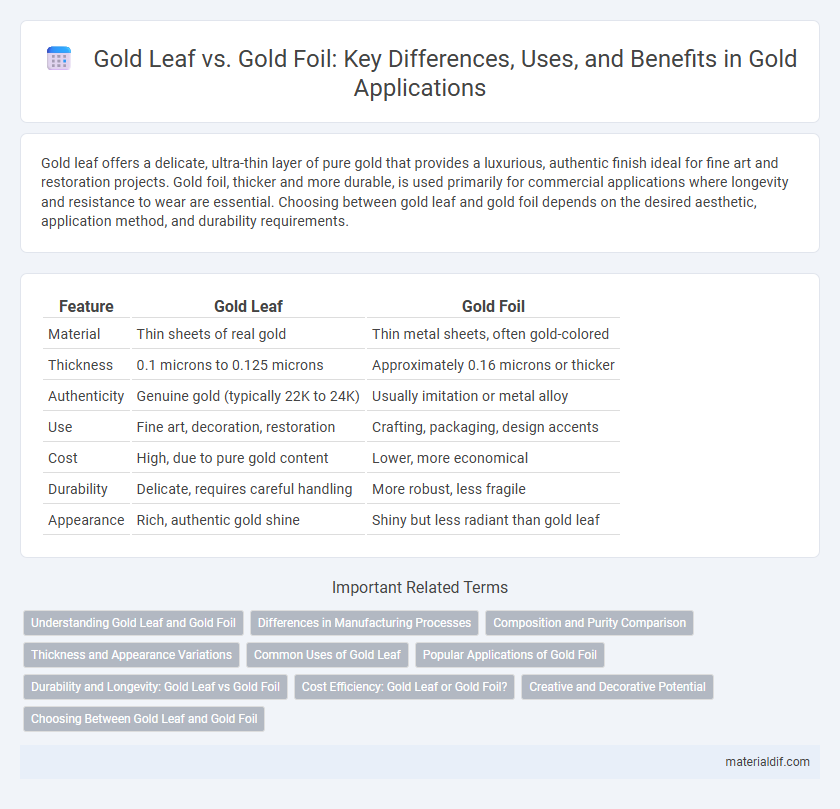Gold leaf offers a delicate, ultra-thin layer of pure gold that provides a luxurious, authentic finish ideal for fine art and restoration projects. Gold foil, thicker and more durable, is used primarily for commercial applications where longevity and resistance to wear are essential. Choosing between gold leaf and gold foil depends on the desired aesthetic, application method, and durability requirements.
Table of Comparison
| Feature | Gold Leaf | Gold Foil |
|---|---|---|
| Material | Thin sheets of real gold | Thin metal sheets, often gold-colored |
| Thickness | 0.1 microns to 0.125 microns | Approximately 0.16 microns or thicker |
| Authenticity | Genuine gold (typically 22K to 24K) | Usually imitation or metal alloy |
| Use | Fine art, decoration, restoration | Crafting, packaging, design accents |
| Cost | High, due to pure gold content | Lower, more economical |
| Durability | Delicate, requires careful handling | More robust, less fragile |
| Appearance | Rich, authentic gold shine | Shiny but less radiant than gold leaf |
Understanding Gold Leaf and Gold Foil
Gold leaf consists of extremely thin sheets of pure gold, traditionally crafted through a labor-intensive hammering process, making it ideal for luxurious gilding applications in art, architecture, and religious artifacts. Gold foil, on the other hand, is typically made from gold alloy or imitation metals, offering a more affordable alternative for decorative purposes but with less durability and luster than genuine gold leaf. Understanding the differences in composition, thickness, and usage helps artisans and designers select the appropriate material for enhancing the visual richness of their projects.
Differences in Manufacturing Processes
Gold leaf is crafted through an extensive beating process that transforms gold into ultra-thin sheets using traditional hand-hammering or mechanical methods, resulting in delicate, translucent layers primarily used for gilding and fine art. Gold foil, in contrast, is produced via rolling or pressing techniques that yield thicker, more durable sheets suitable for industrial applications and packaging. These distinct manufacturing processes affect their thickness, flexibility, and typical usage, with gold leaf offering finer detail and gold foil providing greater structural strength.
Composition and Purity Comparison
Gold leaf consists of ultra-thin sheets of nearly pure gold, typically 22 to 24 karats, prized for its high purity and malleability. Gold foil, while similar in appearance, may contain alloys or lower karat gold, impacting its overall purity and durability. The composition difference directly affects their applications, with gold leaf favored for fine art and decoration due to its purity, and gold foil used in industrial settings where strength is prioritized.
Thickness and Appearance Variations
Gold leaf typically measures around 0.1 microns in thickness, offering an ultra-thin, delicate appearance suitable for intricate decorative work. Gold foil ranges from 5 to 25 microns, providing a thicker, more durable layer with a metallic sheen that is less fragile than gold leaf. Variations in thickness directly influence the texture and application methods, with gold leaf delivering a smoother, almost translucent finish, while gold foil presents a more pronounced, reflective surface.
Common Uses of Gold Leaf
Gold leaf is primarily used in art restoration, gilding of picture frames, and decorative applications on furniture and architectural elements due to its thin, delicate structure that allows for smooth application and a luxurious finish. Unlike gold foil, which is thicker and often used in packaging or industrial processes, gold leaf provides a refined, authentic gold appearance in museums, temples, and high-end crafts. Its malleability makes it ideal for intricate designs and historic preservation work where precision and a genuine gold luster are essential.
Popular Applications of Gold Foil
Gold foil is widely used in architectural gilding, offering durable decorative finishes for ceilings, moldings, and statues in historic buildings and luxury interiors. It is favored in bookbinding and art framing due to its flexibility and ease of application on curved or irregular surfaces. Additionally, gold foil finds popularity in culinary arts, especially for decorating chocolates, cakes, and gourmet dishes to add a touch of elegance and luxury.
Durability and Longevity: Gold Leaf vs Gold Foil
Gold leaf consists of extremely thin, hammered gold sheets that offer superior durability and longevity due to their pure metal content and resistance to tarnishing. Gold foil, often made by bonding gold to a base metal, provides less durability and a shorter lifespan as the underlying material may degrade or discolor over time. For long-term applications where lasting brilliance and wear resistance are crucial, gold leaf is the preferred choice over gold foil.
Cost Efficiency: Gold Leaf or Gold Foil?
Gold foil offers greater cost efficiency than gold leaf due to its manufacturing process, which uses a metal base covered with a thin layer of gold, reducing the amount of pure gold needed. Gold leaf is composed of nearly pure gold and requires delicate handling, resulting in higher material and labor costs. For projects prioritizing budget without sacrificing the gold appearance, gold foil provides a more economical alternative.
Creative and Decorative Potential
Gold leaf offers unmatched versatility for artists and designers, allowing for delicate application on sculptures, paintings, and intricate craftwork, enhancing visual texture and luxury. Gold foil, thicker and more durable, is ideal for decorative accents on packaging, stationery, and signage where structural integrity and bold shine are essential. Both materials unlock unique creative potentials, with gold leaf excelling in fine detail and gold foil providing robust, eye-catching embellishments.
Choosing Between Gold Leaf and Gold Foil
Gold leaf offers an ultra-thin, natural gold finish ideal for fine art, restoration, and luxury decor, providing authentic luster and rich texture. Gold foil, thicker and often machine-produced, suits applications needing durability and coverage, such as craft projects or industrial uses. Selecting between gold leaf and gold foil depends on the desired aesthetic, surface type, and budget, with gold leaf favored for traditional elegance and gold foil for practical versatility.
Gold Leaf vs Gold Foil Infographic

 materialdif.com
materialdif.com